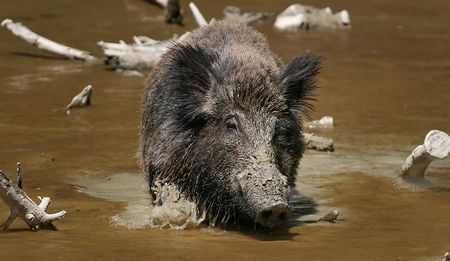Feral hogs are found in a variety of habitats from the lush pine forests of the southeast to the brush country of the southwest. Hogs can handle both cold and hot weather. And though feral hogs do well in a variety of habitats, they prefer bottomlands such as rivers, creeks, and drainages when those habitat types are available. Wild and feral hogs are generally found in dense vegetation cover often associated with water, but also do well in droughty environments, as well. During hot weather, feral hogs will wallow in wet, muddy areas and are never far from dense and protective cover.
Hog are opportunistic and will concentrate in areas of food availability, especially where there are nut (acorn) producing trees or agricultural crops (corn, rice, soybeans, watermelon, etc.). The home range of an individual feral hog is based mainly on food availability and cover. Although the average hog tyically ranges less than 3,000 acres, they can range up to 50,000 acres or more! In general, boars have larger home ranges and will also travel greater distances, although the actual size of the area they use will be based on the proximity of food, cover, and water.
 Feral hogs are omnivorous, meaning they eat both plant and animal matter. They are very opportunistic feeders and much of their diet is based on the seasonal availability of foods, both natural and agricultural. The feral hog diet commonly includes grasses, forbs, roots and tubers, browse, mast (acorns), fruits, bulbs, and even mushrooms. They will also eat frogs, snakes, dead animals, and invertebrates such as insects, snails, earthworms. In short, feral hogs will surive off whatever foods the habitat provides.
Feral hogs are omnivorous, meaning they eat both plant and animal matter. They are very opportunistic feeders and much of their diet is based on the seasonal availability of foods, both natural and agricultural. The feral hog diet commonly includes grasses, forbs, roots and tubers, browse, mast (acorns), fruits, bulbs, and even mushrooms. They will also eat frogs, snakes, dead animals, and invertebrates such as insects, snails, earthworms. In short, feral hogs will surive off whatever foods the habitat provides.
So although feral hogs have demonstrated they can adapt to just about any habitat type, they prefer moist habitats and hog densities are probably highest along streams, rivers, and other riparian-type areas. Hogs also love dense cover, which is typically associated with moist, wet areas. With that said, hogs can surivive under arid conditions as long as adequate surface water is available. Hopefully, this information has helped your better understand the habitat requirements of feral hogs, whether you plan on hunting hogs or just learning about them!